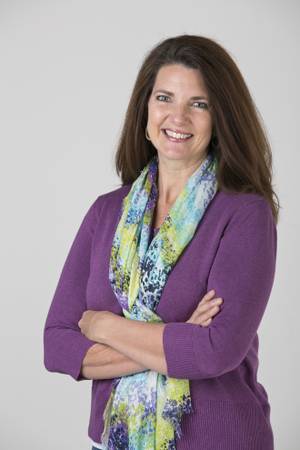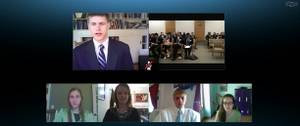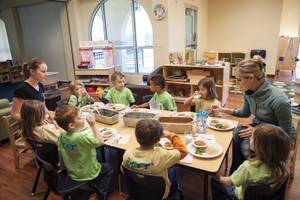Back to School 2014
Last September, the Weekly profiled two new schools reimagining education, hoping to offer something inspiring and effective in a landscape that can be pretty bleak. One year later, we caught up with them to see how they’ve handled challenges and are continuing to grow.
Type: public charter, online
Mission: “To provide highly motivated and self-directed students in Nevada with a classical education so they can become principled leaders.”
After investing about $100,000 in operations and more than a year in crafting their charter, the founders of Leadership Academy of Nevada had to postpone its launch last year due to low enrollment. LANV’s charter application estimated 180 students; on the state’s deadline day, around 60 were in the pipeline.
“It was a huge disappointment and yet a blessing in the long run,” says Valerie Blake, chair of LANV’s governing board and one of the dedicated parents who conceived of a public option in Nevada based on the Williamsburg Academy, a pioneering online high school that recently received the U.S. Distance Learning Association’s Platinum Award for Best Practices in Teaching.
The delay has been an opportunity to refine, from the teaching staff to the school’s message—boiled down to focus areas of leadership, liberal arts and technology. LANV's director, Bryon Richardson, explains that sharing those pillars with a targeted group of students and parents created some real traction. Financial hurdles were stickier, as the state doesn’t contribute until a school reaches its enrollment benchmark, and the State Public Charter School Authority’s $750,000 startup fund is only for reimbursements, not up-front costs (Blake says the Charter School Authority has been very helpful otherwise, and that the chicken-before-egg issue will likely be tackled during the next legislative session).
Daunting as it was, Blake says the founders of LANV and Williamsburg—which is partnering with the Nevada startup to provide curriculum, guidance and 30 percent of the faculty—somehow kept the bills paid and momentum building. The small staff donated most of its time to accommodate about $40,000 needed to keep the school afloat over the past year. They crisscrossed the state with Williamsburg students speaking for the model in libraries and the homes of interested families. They networked with businesses and politicians. They expanded the scope from grades 9-12 to 6-12. Going into the first day of school August 20, the enrollment tally was, as Operations Manager Angie Kleven put it, “amazing.” Almost 200 are enrolled, with more in process.
Many of those students come from homeschool backgrounds or have experienced online education and are looking for a more rigorous program, though Kleven says others are leaving the traditional public system for LANV’s Williamsburg backbone of the Socratic method based in the liberal arts with the goal of cultivating critical thinking and leadership. While the online classroom is unnerving for some, 16-year-old Donovan Kleven says it’s “much more social than you would imagine.” LANV students are provided laptops if needed and get to keep every book they read. Their teachers span the country, and their classmates live all over Nevada. Anything below a 70 percent is a failing grade, but students always have the choice to keep working for better scores and deeper understanding.
“Typical public school is kind of artificial that way, in that it just cuts them off and moves them on. But in real life when you want to improve on something, you do,” Blake says. LANV’s training extends to service, as students are taught to develop personal leadership skills in order to “make a meaningful difference in the world.” She mentions a Williamsburg project that had middle-schoolers teaming up with the nonprofit CHOICE Humanitarian to provide water cisterns in a poor Mexican village.
Some parents may not see the relevance of devoting school time to such efforts, or the appeal of students debating landmark Supreme Court cases via webcam. LANV’s model isn’t right for everyone, Kleven insists, but as a parent she wanted the choice.
“We’re doing something completely different curriculum-wise … and it’s parent-controlled and parent-run and parent-founded,” she says. “Our first three years we want to grow but not overwhelm ourselves at all that it would sacrifice the quality of what we’re doing.”
Type: private, brick-and-mortar
Mission: “To transform education by redefining the experience of school.”
With 15 students, nine teachers and a beautifully renovated church complex in Downtown Las Vegas, 9th Bridge celebrated its first day of school on August 26, 2013. But school is defined differently here, based on an original model for early childhood education that came not only from a formidable think tank of education experts, but also from leaders in fields like neuroscience and positive psychology. It taps into the way a child’s brain works and nurtures unique learning styles within that framework, whether kids are taking on science, language acquisition or multicultural arts.
With something so progressive, you would expect some growing pains the first year. But 9th Bridge Director Nikki Goldstein says the open model means adjustments can happen in the moment, so challenges don’t intensify to pains. “Every little piece that didn’t seem to fall into place we question and we wonder why; we wonder, what did we miss and what do we need to add in? And then we just do. And it improves.”
Sometimes that meant altering a lesson; sometimes it meant knocking down a wall. But the foundational premise that each student has the latitude to develop on his or her own terms is set in stone. That’s why grade movement is based on development, not age. “We always take our cues from their needs, from the family needs, from the feedback we’re getting from the teachers in the room,” Goldstein says.
By the end of last year the student body had grown to 28, almost double, and there may be more when 9th Bridge starts its second year on August 25. The school is now offering a part-time program for toddlers and pre-K, and the kindergarten class has filled out, with plans on track to add first grade the following year and so on, until 9th Bridge can take students from infancy through high school.
Parts of the still-new facility are already being remodeled, from transforming the reading room into a music room for composing, playing and recording to making the teacher’s lounge a place for relaxation and brainstorming on a custom whiteboard that is an entire wall. 9th Bridge founder Connie Yeh is working on accreditation from the National Association for the Education of Young Children, but she sounds more excited about the ceramic mosaics students made in a workshop with Burning Man artists, and the yoga class taught by one of the kid's grandmothers.
“Those kinds of opportunities come to us because we’re willing to be open to cultivating those relationships. A lot of schools don’t do that. They spend a lot of time being very isolated in their own little bubbles,” Goldstein says, “but we’re so open to it not looking like that.”
In that vein, you might see 9th Bridge parents skateboarding their kids to school, getting in on grilled cheese/tomato soup day during family lunch or singing at Connections. “At the start of every school day, for the first 15 minutes, all of our students, teachers, parents, administration come together and do a school-wide activity,” Yeh explains. Whenever they wish, parents can observe their kids at work, hang out in common areas with a coffee, or share ideas about where 9th Bridge should go next.
“I strongly believe that this is a partnership,” Goldstein says. “I think that’s a big thing that draws families to us. They like that they’re going to be connected to what’s happening for their child.”




